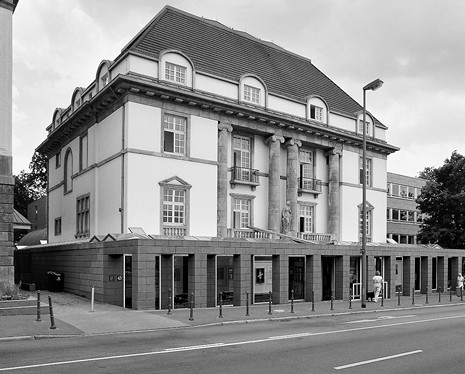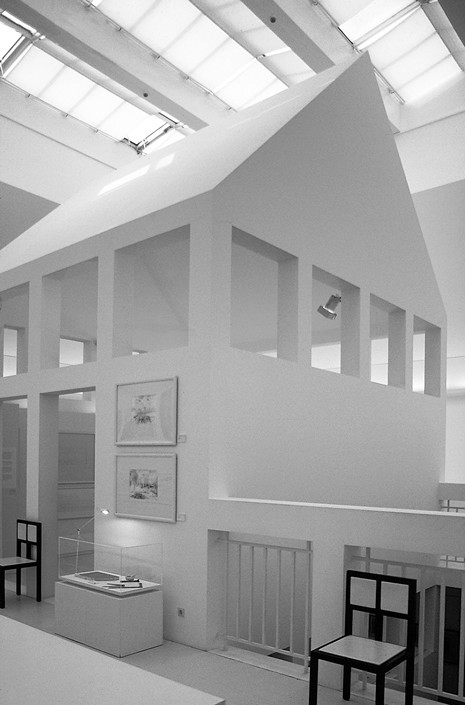Description
The first project on the Museumsufer in Frankfurt, initiated by Heinrich Klotz in 1979 as a documentation and exhibition centre for contemporary architecture, is not a new building, strictly speaking, but a conversion or more precisely, an installation. The plinth zone of a neo-classicist villa by Fritz Geldmacher that dates back to 1912/13 was surrounded by a columned hall of red sandstone with a glass roof; on one side, it condenses into a ‘city wall’ and on the garden side, it widens out into a glass-roofed pavilion. In every detail, right down to the floor surface, the structure of this pavilion – which encloses a tiny inner courtyard with a carefully conserved tree – demonstrates the omnipresence of the quadrate or rather the cube, which dominates the whole building as a modular system. (Glass roofing that had begun to leak, in the meantime replaced by lead roofs, disrupt the intended spatial impression considerably.)
Through this enclosure, the old villa itself is turned into an exhibition piece, whose gutted interior, toplighted by a glass roof, in turn hides an entirely new volume with five exhibition levels. With absolute logical consequence, a dazzling white structure crowned by a gable roof is developed out of the most elementary form of a building, the house with four supporting pillars; it offers fascinating spatial experiences demonstrating by his own example what architecture can be. The architect and theoretician O. M. Ungers writes about this ‘building within a building:’ “this reversal from inside to outside, this entrance into a room and in so doing, being outside the next room, consciously exploits an opportunity to experience space. This is the theme of the architectural museum…”
As convincing as architecture has become here, as the “semantic support of a representable fiction,” it can only fulfil to a limited extent its task as exhibition space for the museum’s objects (drawings, plans, and models), because the artificial perfection of this spatial structure (that nonetheless cannot avoid undesired residual space such as the all-too-small hallways on the ground floor) makes any addition or change into a potential disturbance – unless it fits into the modular basic structure of the omnipresent quadrate.
Baumeister 8/1984, pp. 31-39 • L’architecture d’aujourd’hui 233/ 1984, pp. 10-13 • Lotus international 3/1984, pp. 7-22 (Heinrich Klotz) • Architectural Record August 1984, pp. 104-117 (Barry Bergdoll) • Casabella Sept. 1983, pp. 14-23 (Pierre-Alain Croset/Heinrich Klotz) • The Architectural Review 1050/1984, pp. 30-38 (Vittorio Magnago-Lampugnani) • Deutsches Architekturmuseum Frankfurt am Main. Festschrift zur Eröffnung am 1. Juni 1984, Frankfurt, 1984 • Hannelore Schubert, Moderner Museumsbau, Stuttgart, 1986, pp. 152-154 • Vittorio Magnago Lampugnani (ed.), Museumsarchitektur in Frankfurt 1980-1990, Munich, 1990, pp. 138-151 (Heinrich Klotz) • Oswald Mathias Ungers. Architektur 1951-1990, Stuttgart 1991, pp. 108-117 • Martin Kieren, Oswald Mathias Ungers, Zurich/Munich/London, 1994, pp. 114-119 • Josep M. Montaner/Jordi Oliveras, Museums for a New Century, Barcelona, 1995, pp. 86-89 • Gert Kähler, Ein Jahrhundert Bauten in Deutschland, Stuttgart/Munich, 2000, pp. 192-193
Drawings
First underground level
Ground floor
Second floor
Third floor
Fourth floor
Sectional axonometric view
Photos

Exterior view from the bank of the river Main

“House” on the top floor
Originally published in: Paul von Naredi-Rainer, Museum Buildings: A Design Manual, Birkhäuser, 2004.